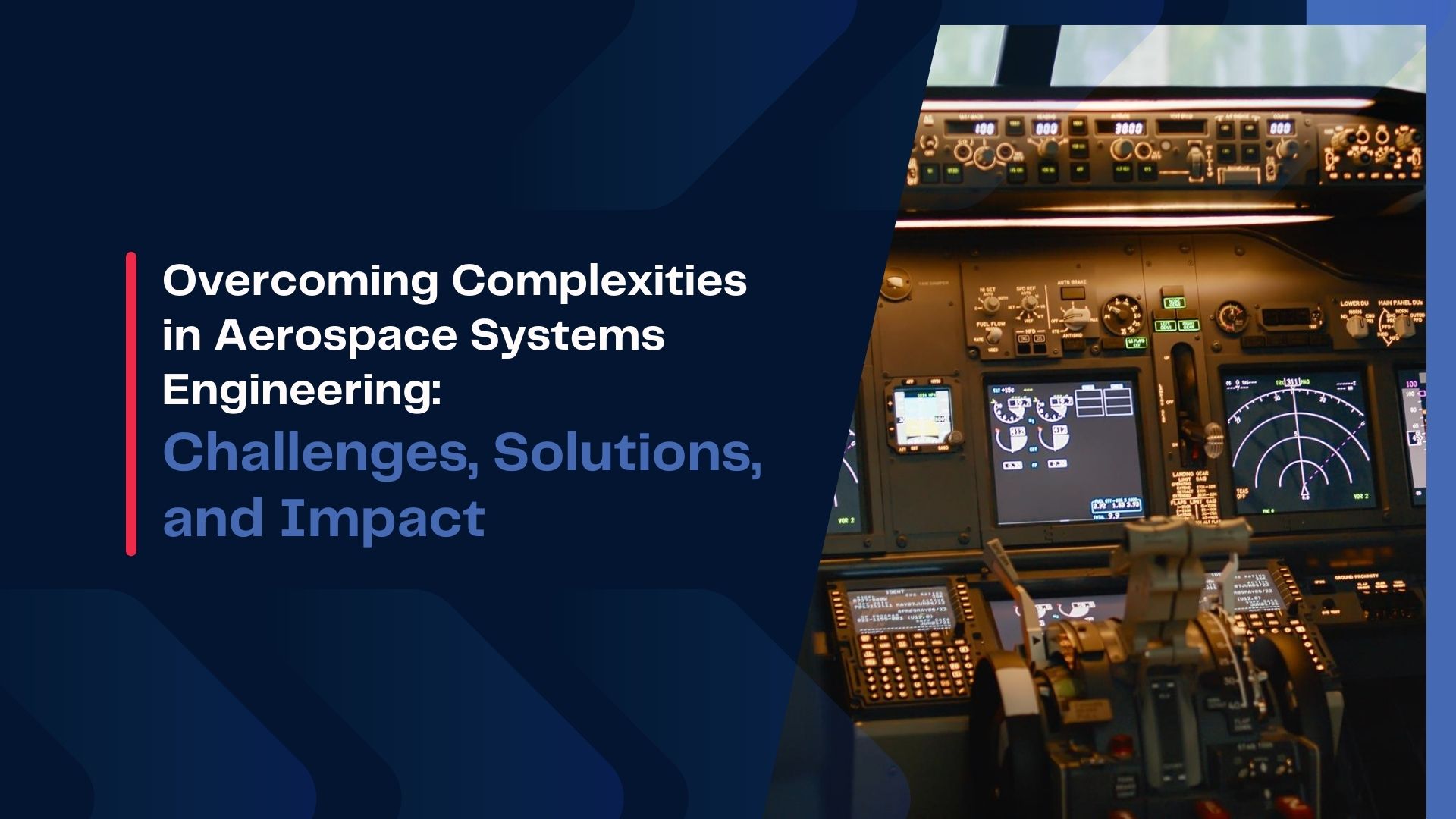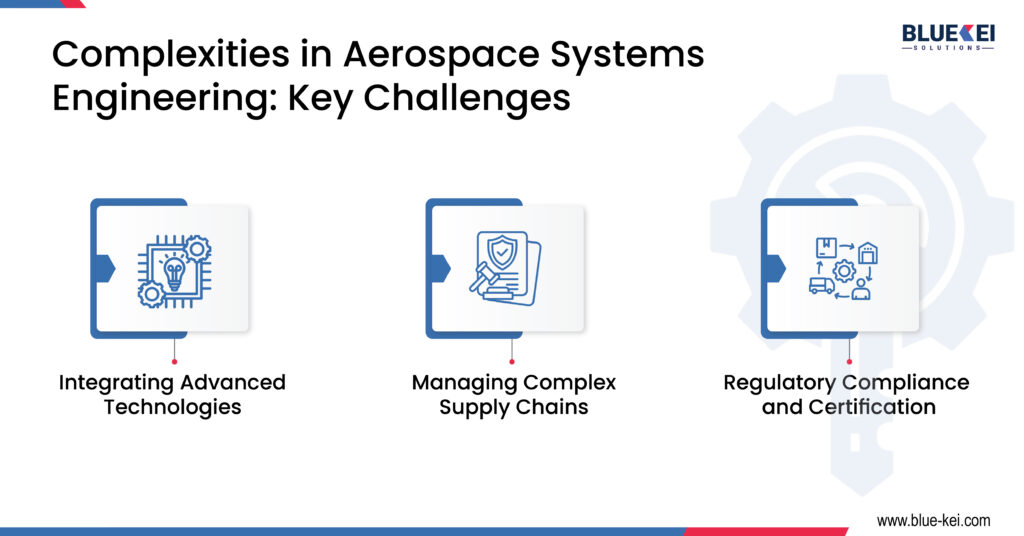Overcoming Complexities in Aerospace Systems Engineering: Challenge, Solution, and Impact
At the vanguard of technical innovation, aerospace systems engineering adds a new level of complexity with each advancement in aviation and space exploration. This degree of complexity is organizational in nature as well as technical, involving the complex design, integration, and testing of extremely sophisticated components. It necessitates smooth collaboration between multidisciplinary teams, stringent adherence to legal requirements, and effective time and resource management.

System Engineers deal with several complex problems that call for creative solutions in everything from managing business requirements to planning complex space missions and creating next-generation aircraft. These challenges include collaborating across disciplines, managing the inherent complexity of advanced systems, traversing strict regulatory frameworks, assuring system reliability, and seamlessly integrating cutting-edge technologies.
Challenge 1
Integrating Advanced Technologies
A major problem in aerospace systems is integrating advanced technologies, especially when it comes to guaranteeing the smooth operation of complex electronics, propulsion systems, and avionics in contemporary aircraft and spacecraft. A modern fighter plane, for example, needs to have sophisticated radar systems, sophisticated missile guidance, and strong but efficient engines that work well together in harsh environments like high speeds and different altitudes. The intricacy stems from having to make sure these disparate technologies work together as well as the requirement to maximize their efficiency while upholding strict safety regulations. This calls for careful coordination between many technical teams, extensive testing to avert malfunctions, and ongoing innovation to meet new operational requirements and emerging risks.
Solution: Systems Integration and Simulation
Aerospace systems engineers tackle the challenge of integrating advanced technologies through rigorous systems integration and simulation. This requires interdisciplinary collaboration, where experts in electronics, propulsion, and avionics work together to optimize system performance while addressing specific subsystem challenges. For example, balancing the power demands of radar systems with engine efficiency requires expertise in both electrical engineering and aerodynamics. Digital twins play a crucial role by offering dynamic, real-time simulations that mirror physical systems, unlike traditional models that provide static snapshots. This allows engineers to predict and resolve potential issues with greater accuracy, ensuring robust performance in real-world operations.
Impact: Enhanced Safety and Efficiency
Effective system integration in aerospace enhances reliability, reduces development time, and minimizes errors throughout the system lifecycle. By ensuring subsystems work seamlessly, it improves design robustness, operational performance, and compliance with regulations. This integration drives innovation, enabling the industry to tackle complex challenges and deliver advanced solutions.
System engineers can mitigate risks associated with failures by introducing redundancies and fail-safes at the architectural level, enhancing overall efficiency and significantly bolstering the safety and reliability of both aircraft and spacecraft. Incorporating advanced simulations into the design and development process further strengthens this approach. Simulations allow engineers to model complex scenarios, identify potential failure points, and refine system architecture before physical implementation. This proactive testing helps to optimize designs, validate redundancy strategies, and ensure that the integrated system will perform reliably under various conditions, ultimately reducing the risk of unforeseen issues during operation.

Challenge 2
Managing Complex Supply Chains
Another critical challenge in aerospace systems engineering is managing complex supply chains. From sourcing specialized components to coordinating international logistics, the industry relies on a vast network of suppliers and manufacturers. Any disruption within this intricate web can cascade into delays and cost overruns, affecting project timelines and budgets.
Solution: Supply Chain Optimization and Risk Management
Addressing supply chain complexities requires a strategic approach to optimization and risk management. Aerospace companies employ the systems engineering method, which integrates all aspects of the supply chain into a cohesive framework. This method ensures that every component, from procurement to delivery, is optimized for efficiency and reliability. By investing in robust supplier relationship management systems and leveraging data analytics and predictive algorithms, companies can identify potential bottlenecks, implement contingency plans, and proactively mitigate risks. This holistic approach enhances transparency, strengthens supplier relationships, and ensures the smooth operation of the entire supply chain.
Impact: Streamlined Operations and Cost Efficiency
Addressing supply chain complexities requires a strategic approach to optimization and risk management, where the systems engineering plays a crucial role. Aerospace companies invest in robust supplier relationship management systems that prioritize transparency and reliability. By applying systems engineering principles, they ensure that all aspects of the supply chain are holistically integrated, from procurement to delivery. Leveraging data analytics and predictive algorithms, companies identify potential bottlenecks and proactively implement contingency plans to mitigate risks. This methodical approach not only enhances the resilience of the supply chain but also ensures that all components work seamlessly together, supporting overall operational efficiency.
Challenge 3
Regulatory Compliance and Certification
Navigating stringent regulatory frameworks and obtaining certifications is a perennial challenge for aerospace systems engineers. Aircraft and spacecraft must adhere to a myriad of safety and performance standards set forth by international aviation authorities. A higher level of scrutiny is needed to guarantee the security and dependability of cutting-edge technologies because aerospace frequently functions in uncontrolled environments. Disregarding unnecessary rules might impede the development of technology and discourage industry innovation.
Solution: Collaboration and Continuous Improvement
System engineers work closely with regulatory bodies during design and development, using methodologies like requirements engineering and model-based systems engineering to ensure compliance. By integrating regulatory requirements early and using systems engineering to simulate compliance scenarios, they translate complex standards into actionable design criteria. Continuous improvement, driven by feedback from past certifications, helps aerospace companies refine these practices, staying aligned with evolving regulations while maintaining safety and reliability.
Impact: Sustained Innovation and Global Market Access
The impact of regulatory compliance extends far beyond mere legal obligations. Adhering to stringent international standards allows aerospace companies to access and compete in global markets, which fosters their competitiveness and drives technological innovation. Compliance ensures safety and reliability, which are paramount in building and maintaining customer trust. This trust, in turn, positions these companies as industry leaders in a highly competitive market; they are seen as reliable and forward-thinking, continually pushing the boundaries of aerospace technology.
Pushing Boundaries: Innovating the Future of Aerospace Systems Engineering
Aerospace systems engineering represents the epitome of human ingenuity and perseverance, where overcoming challenges is synonymous with driving innovation and fostering collaboration. The integration of cutting-edge technologies, from advanced avionics to next-generation propulsion systems, stands as a testament to our ability to push the boundaries of aerospace engineering. Simultaneously, optimizing intricate supply chains ensures the seamless flow of critical components, supporting the timely delivery and assembly of aircraft and spacecraft.
Navigating stringent regulatory landscapes demands meticulous attention to detail and a proactive approach to compliance, ensuring that every design meets rigorous safety and performance standards. Each challenge surmounted through these efforts contributes to a collective advancement in aerospace capabilities, shaping a future where air and space travel are not just efficient and safe but also transformative in their potential to explore new frontiers beyond Earth’s atmosphere.
In this dynamic vertical, the pursuit of overcoming complexities transcends mere problem-solving; it embodies our relentless quest to pioneer new technologies and inspire future generations in the realm of aerospace systems engineering.
We saw how businesses benefit from the systems engineering approach. There is much to explore and achieve. You may also want to reap the benefits of this approach. Let BlueKei help your organization leverage systems engineering to its full potential. Contact us to schedule a call to get things going!
If you are interested in understanding how to adopt systems engineering and model based systems engineering practices within your organization, reach out to BlueKei Solutions team at info@Blue-Kei.com. We specialize in systems engineering consulting, project executions, process adoptions such as compliance to ISO15288, ARP 4754A, ISO 42020, digital transformations. We can also conduct capability development workshops which are experiential and tailored to your needs. With systems engineering adoption you can address the complexity, manage evolving risks and bring transformation in communication within your organization through digitalization and create the digital thread.
Post Views: 486

